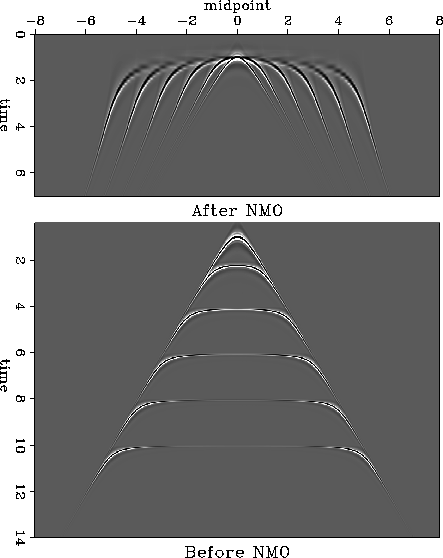![[*]](http://sepwww.stanford.edu/latex2html/cross_ref_motif.gif) and
analyzed theoretically later in this chapter.
and
analyzed theoretically later in this chapter.
![[*]](http://sepwww.stanford.edu/latex2html/cross_ref_motif.gif) , an ideal regularization results from a
data-space differential equation that we assume to be satisfied by the
input data. Laplace's equation is appropriate for certain kinds of
potential-field data, and the biharmonic equation applies to smooth
elastic-type surfaces. A special differential equation is required to
characterize the predictable features of seismic reflection data.
, an ideal regularization results from a
data-space differential equation that we assume to be satisfied by the
input data. Laplace's equation is appropriate for certain kinds of
potential-field data, and the biharmonic equation applies to smooth
elastic-type surfaces. A special differential equation is required to
characterize the predictable features of seismic reflection data.
Fortunately, such an equation does exist. I introduce it in this chapter and study its theoretical properties. The equation describes the process of offset continuation , which is a transformation of common-offset seismic gathers from one constant offset to another Bolondi et al. (1982). Bagaini et al. (1994) identified offset continuation (OC) with a whole family of prestack continuation operators, such as shot continuation Bagaini and Spagnolini (1993); Schwab (1993), dip moveout as a continuation to zero offset, and three-dimensional azimuth moveout Biondi et al. (1998); Biondi and Chemingui (1994a).
The Earth subsurface is a three-dimensional object, while seismic
reflection data from a multi-coverage acquisition belong to a
five-dimensional space (time, 2-D offset, and 2-D midpoint
coordinates). This fact alone is a clear indication of the
additional connection that exists in the data space. The offset
continuation equation expresses this connection in a concise
mathematical form. Its theoretical analysis allows us to explain the
data transformation between different offsets. A simple example is
the diffraction point response shown in Figure ![[*]](http://sepwww.stanford.edu/latex2html/cross_ref_motif.gif) and
analyzed theoretically later in this chapter.
and
analyzed theoretically later in this chapter.
 |
![[*]](http://sepwww.stanford.edu/latex2html/cross_ref_motif.gif) ).
).
As early as in 1982, Bolondi et al. came up with the idea of describing offset continuation and dip moveout (DMO) as a continuous process by means of a partial differential equation Bolondi et al. (1982). However, their approximate differential operator, built on the results of Deregowski and Rocca's classic paper Deregowski and Rocca (1981), failed in the cases of steep reflector dips or large offsets. Hale (1983) writes:
The differences between this algorithm [DMO by Fourier transform] and previously published finite-difference DMO algorithms are analogous to the differences between frequency-wavenumber Gazdag (1978); Stolt (1978) and finite-difference Claerbout (1976) algorithms for migration. For example, just as finite-difference migration algorithms require approximations that break down at steep dips, finite-difference DMO algorithms are inaccurate for large offsets and steep dips, even for constant velocity.Continuing this analogy, one can observe that both finite-difference and frequency-domain migration algorithms share a common origin: the wave equation. The new OC equation, presented in this chapter
![[*]](http://sepwww.stanford.edu/latex2html/foot_motif.gif) and valid for all offsets and
dips, plays a role analogous to that of the wave equation for offset
continuation and dip moveout algorithms. A multitude of seismic
migration algorithms emerged from the fundamental wave-propagation
theory that is embedded in the wave equation. Likewise, the
fundamentals of DMO algorithms can be traced to the OC differential
equation.
and valid for all offsets and
dips, plays a role analogous to that of the wave equation for offset
continuation and dip moveout algorithms. A multitude of seismic
migration algorithms emerged from the fundamental wave-propagation
theory that is embedded in the wave equation. Likewise, the
fundamentals of DMO algorithms can be traced to the OC differential
equation.
In the first part of the chapter, I prove that the revised equation is, under certain assumptions, kinematically valid. This means that wavefronts of the offset continuation process correspond to the reflection wave traveltimes and correctly transform between different offsets. Moreover, the wave amplitudes are also propagated correctly according to the true-amplitude criterion Black et al. (1993). The amplitude and phase preservation is additionally confirmed by a direct theoretical test, where I represent the input common-offset data by the Kirchhoff modeling integral Bleistein (1984). The first two asymptotic orders of accuracy are satisfied when the offset continuation equation is applied to the Kirchhoff data.
In the second part of the chapter, I relate the offset continuation equation to different methods of dip moveout. Considering DMO as a continuation to zero offset, I show that DMO operators can be obtained by solving a special initial value (Cauchy-type) problem for the OC equation. Different known forms of DMO Hale (1991) appear as special cases of more general offset continuation operators.